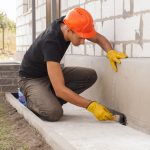The Best Way To Maintain Your Retaining Wall
A retaining wall is a vital feature of your landscape for both aesthetic and functional purposes. To ensure your retaining wall remains in great shape, it is crucial to conduct regular maintenance. If your wall’s structural integrity has been compromised, you may require a reputable professional to carry out an inspection.
Nothing is as convenient as a retaining wall when it comes to terraced or sloped properties. Not only is it gorgeous, but it is practical and helps you utilize the outdoor space properly.
Do I need to maintain my retaining wall?
During winter, your retaining wall most likely needs maintenance, lest the cold weather weakens it. In the beginning, you might think your wall is okay, despite showing signs of wear and tear. Ignoring these signs can spell disaster in sooner than later.
Often, cold weather creates cracks in your wall. A small crack can result in a bigger one, impacting the integrity of your retaining wall, eventually leading to its collapse. To avoid rebuilding a section of or your entire retaining wall, you must take care of the cracks as soon as you notice them.
How do I maintain my retaining wall?
Below are some tips on retaining wall maintenance.
- Regularly inspect the retaining wall: When inspecting your wall, check for cracks and patch any gaps, as missing mortar will only worsen with time. Additionally, check out for bulges in your retaining wall. If you notice some bowing-out sections, it implies the soil is shifting and might cause a breach soon. In such a situation, you may require a professional to assess the wall and advise accordingly.
- Do not treat your retaining walls in advance: It is tempting to coat the retaining wall in ice prevention solutions before snowfall sets in. However, these compounds slowly erode the stones, causing more damage than good. Consistent wall maintenance is critical in ensuring your retaining wall remain in its best shape.
- Remove debris from the drainage pipes: In some circumstances, your retaining walls will have drainage pipes fitted so that water runoff does not pool at their base. Often the drain pipes are made of thick plastic that does not crack or rust when winter sets in. Nevertheless, the tube can get blocked, especially if there is snow in your area. Thus, you should regularly inspect the drainage pipe and unclog it.
- Fill in eroded parts: After winter, you are likely to see effects of erosion, since snow melt and water runoff take some soil with it as it thaws. Any missing soil on the ground around the wall, mainly on the top surface, may cause pooling, which erodes the stones faster. Therefore, you should refill any depressions to avoid pooling when it rains.
- Replant any dead plants: Generally, soil integrity is key in ensuring the stability of your retaining. Luckily, among the best ways to keep the soil compact is to plant grass or trees on the ground on the top side of the wall. Their roots assist in holding the soil in place and minimizing erosion. During spring, you will likely see some dead plants along your wall. You will thus need to replant appropriately.
Are you looking for a professional to repair your retaining wall? Since 1912, Langenfeld Masonry & Concrete has been servicing Kenosha, South Milwaukee, and Racing counties. Our many years of experience have built us a reputation in the community as the leading masonry and concrete contractors in the construction industry. We specialize in concrete repair, patios, sidewalks, and driveways. Moreover, we also offer foundation pouring, repair, basement waterproofing, and more. Call (262) 639-9257 or email us at http://langenfeldmasonry.com for more information.
More...
Categorised in: Retaining Walls




